
In 2024, Rootjunky APK To Bypass Google FRP Lock For Google Pixel Fold

Rootjunky APK To Bypass Google FRP Lock For Google Pixel Fold
Factory Reset Protection (FRP) is a security feature built into Android devices running Android 5.1 Lollipop and later versions. It prevents someone from using your phone after a factory data reset without Google account login credentials. The FRP makes it much less attractive for thieves to steal Android phones, knowing they will need help to access them.
FRP automatically activates when you add a Google account to your Android phone. It links the Google Pixel Fold device to your account, making it the “trusted owner.” Once activated, FRP becomes embedded in the phone’s system.
While Google FRP is a valuable security feature, it’s vital to acknowledge that there are legitimate situations where bypassing it might be necessary. These instances include forgotten Google account credentials, buying a second-hand device, and device issues. In these cases, tools like RootJunky can help you bypass FRP Lock. We’ll explore how to use RootJunky APK later, but first, let’s define what it is and its role in FRP bypass.
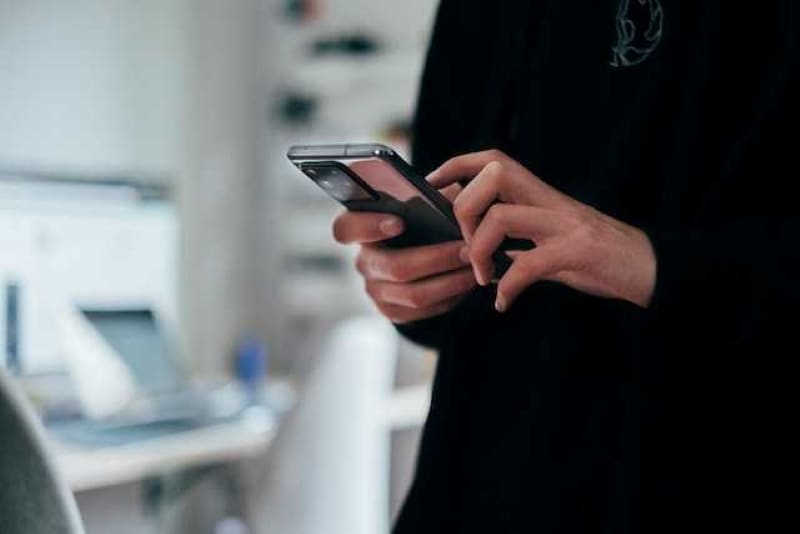
The RootJunky APK is a free Android application also called RootJunky SDL or RootJunky FRP Bypass tool. This app’s primary function is to bypass the Google Account FRP lock on Samsung devices. Rootjunky uses the weaknesses in Android’s setup process to create a new user account or switch existing ones, letting you bypass the FRP and regain control of your phone.
You can complete this process using the app by connecting your phone to a computer through an OTG cable. RootJunky can be helpfu l if you’ve forgotten your Google account password or bought a second-hand phone locked to someone else’s account. However, only use it if you have legitimate reasons to bypass FRP lock, like accessing your device after forgetting your Google account details.

Downloading the RootJunky FRP bypass tool from unofficial sources can introduce malware risks, so stick to trusted sources like the official website. Additionally, when exploring RootJunky, it is vital to keep the following in mind:
- Not all Android devices are susceptible to the methods used by RootJunky. It is necessary to check compatibility with your specific device model and Android version.
- Using FRP bypass tools like RootJunkycan potentially compromise the security of your device. Be cautious and proceed if you fully understand the risks involved.
- Bypassing FRP may involve data loss.
- Download RootJunky FRP bypass APK from a reliable source to minimize the risk of malware or viruses. You can check the APK file from official websites or trusted forums.
- Google constantly updates its security measures, so these tools may not always work effectively.
Part 2: How To Use RootJunky To Bypass Google FRP?
Here are the general steps to use the FRP Bypass APK RootJunky app to bypass Google FRP lock. But remember that specific steps may vary depending on your device and Android version:
- Step 1: On your computer, download the Rootjunky RealTerm program from the official Rootjunky website.

- Step 2: On your phone, download the Rootjunky APK (com.rootjunky.frpbypass-1.0.apk) file from the official website or other reputable sites.

- Step 3: Go to Settings > Security and tap Install unknown apps. Then, enable unknown sources to allow installation of apps from outside the Play Store. Connect your device to a Wi-Fi network.

- Step 4: On your Android phone, open a file explorer app and install the downloaded RootJunky APK file.
- Step 5: Connect your smartphone to your computer using a USB cable.
- Step 6: Launch the Rootjunky RealTerm program on your computer. Under the Display tab, check the Half Duplex option.
- Step 7: On your computer, go to Device Manager > Modems. Locate your device’s port name (e.g., COM3).
- Step 8: On the RealTerm program, enter the correct port number under the Ports tab, then click Change.

Step 9: Click Send to establish a connection. Enter the two commands:
at + creg? \ r \ n
atd1234; \ r \ n
Step 10: Once connected, the Rootjunky APK on your phone will provide on-screen instructions to bypass FRP.
Step 11: If prompted, perform a factory data reset of your device.
While RootJunky offers a free method for FRP bypass, it can be incompatible with your device’s brand, requiring technical knowledge, tedious, and potentially risky. If you are looking for a simpler, safer, and more user-friendly solution, Wondershare Dr.Fone might be a better fit for you. If you want to learn how to use this tool to bypass FRP lock with minimal technical expertise, then keep reading.
Part 3: Easier Tool Than RootJunky APK To Bypass Google FRP
Google FRP adds an extra layer of security after a device reset. However, regaining access to the smartphone can be challenging if you forget your Google account details, forget your lock screen, or just buy a used device. While methods like the FRP RootJunky app exist, using it can be complex or risky.
Consider exploring third-party options like Dr.Fone for a potentially easier and safer FRP bypass solution. Dr.Fone Screen Unlock tool helps remove the Android FRP lock without requiring a PIN or Google Account.
Why Use Dr.Fone - Screen Unlock?
Here are some of the key features of Dr.Fone - Screen Unlock:
- **User-friendly:**Fone boasts an intuitive interface, eliminating the need for technical expertise. Even beginners can navigate the process with ease.
- **Widespread Brand Compatibility:**Fone supports mainstream brands, such as Samsung, Xiaomi, Oppo, Redmi, Realme, and Vivo, catering to a broader user base.
- **Fast and Efficient:**Regain access to your device in minutes without wasting time on tedious procedures.
Step-by-step Guide to Removing FRP Lock With Dr.Fone - Screen Unlock
Ready to leave the hassle of using RootJunky and easily bypass the FRP lock? Download and install Dr.Fone on your computer, then follow these steps to learn how to bypass Google FRP on your device:
- Step 1: Launch Dr.Fone on your computer and connect it to your Android device. Choose Screen Unlock from the Toolbox in the main interface.

- Step 2: Choose Android as your device type. This will take you to the next screen, where you can select Remove Google FRP Lock to proceed.

- Step 3: Select your device’s brand from the list and click Start to continue.
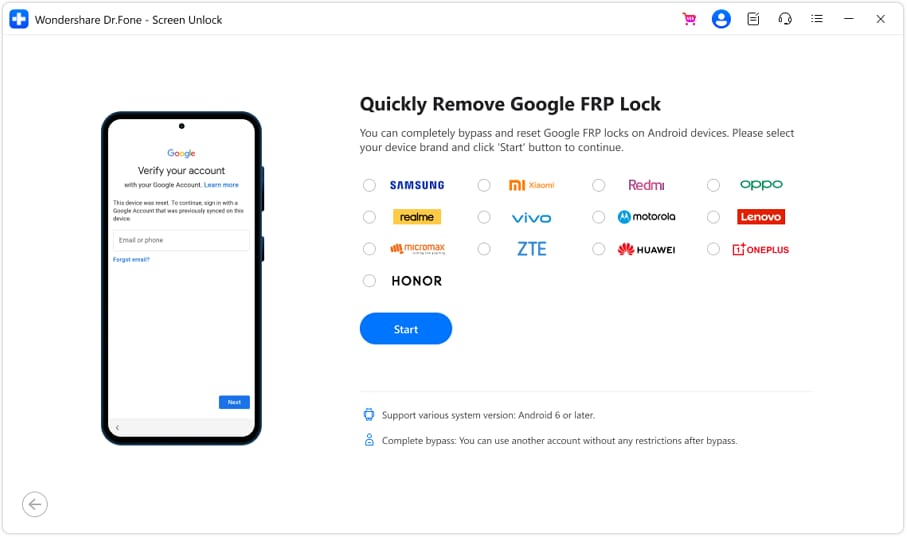
Note:
The next steps may vary depending on the brand you selected.
- Step 4: Select the OS version of your device and click Start to continue.
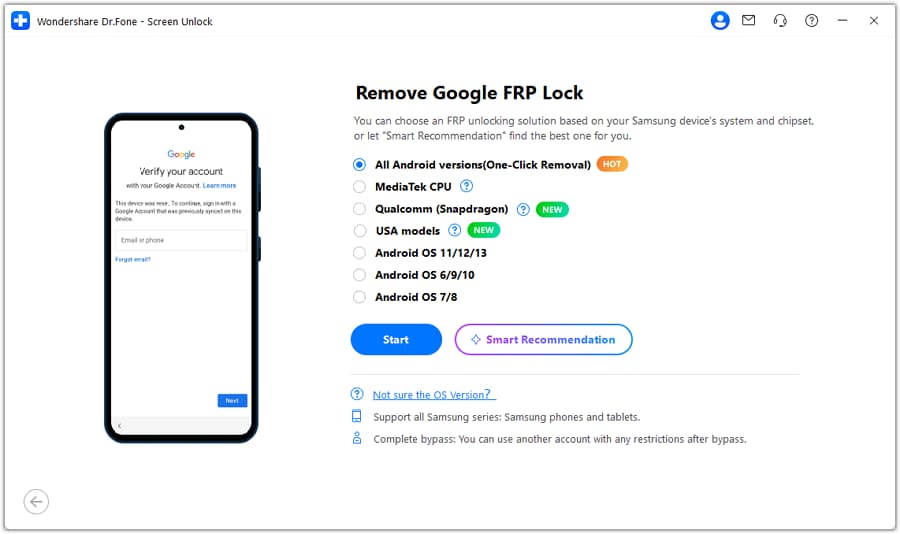
- Step 5: Access the secret menu on your phone using the on-screen instructions, then click Next to proceed to the next step.
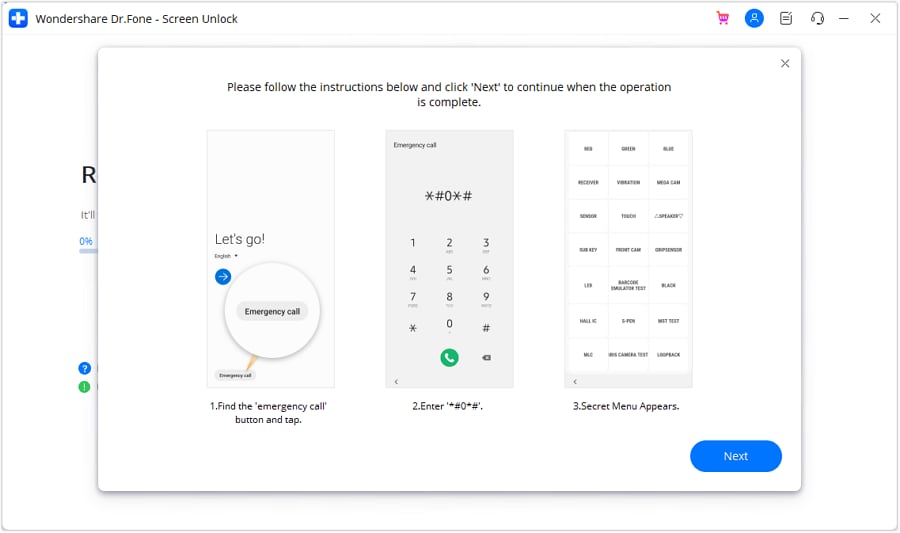
- Step 6: When your Samsung prompts you to activate USB debugging, tap Allow. Then, on your computer screen, click Authorized to confirm.

- Step 7: You will see the FRP lock being bypassed on your Android device on the next screen.
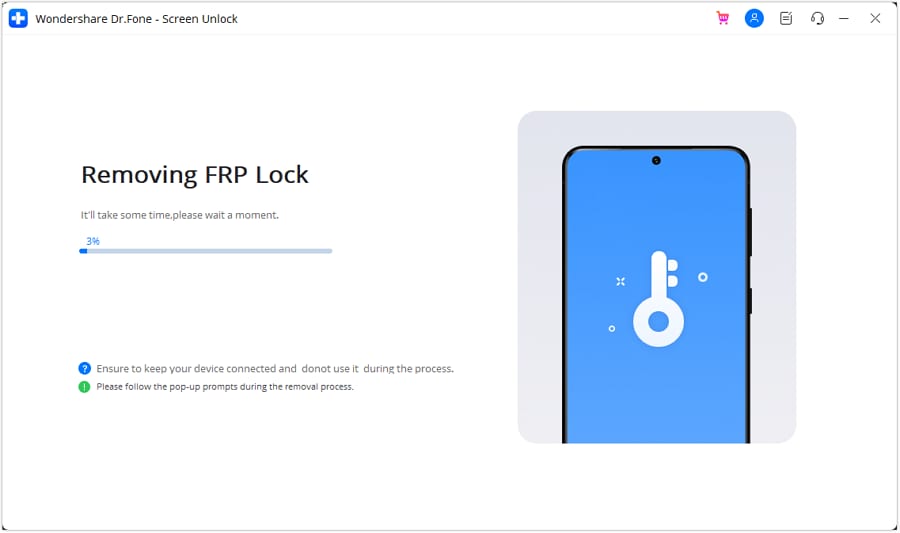
- Step 8: Click Done if the FRP lock removal was successful, otherwise, click Try Again to repeat the process.
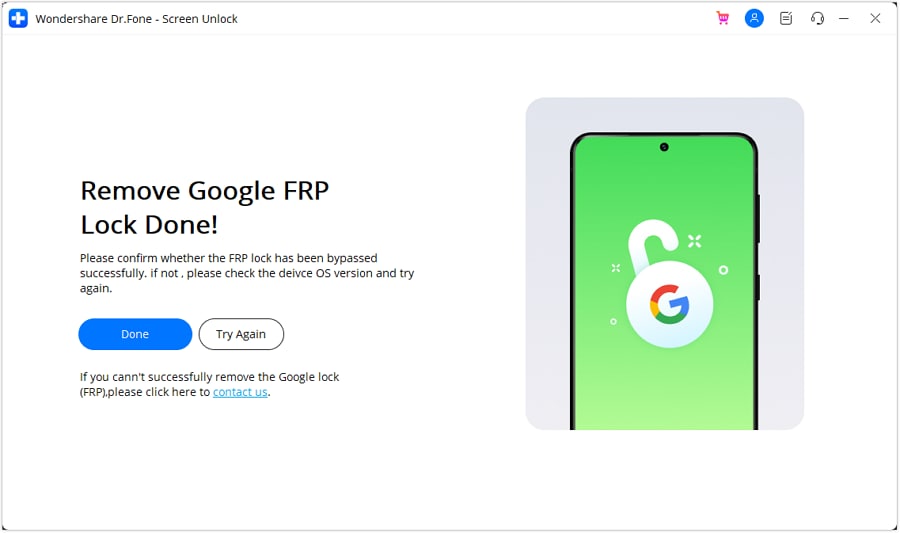
That’s it! With Dr.Fone Screen Unlock, you can easily bypass Google FRP and regain access to your Android device, leaving the complexities of RootJunky behind.
Tips: Are you searching for a powerful FRP bypass tool? No worries as Dr.Fone is here to help you. Download it and start a seamless unlock experience!
Conclusion
Both RootJunky and Dr.Fone offer options for you to regain control of phones with Google FRP lock. FRP Bypass RootJunky tool excels with its free-to-use approach, perfect for tech-savvy users comfortable with APK installations. While requiring a paid subscription, Dr. Fone provides pre-rooted firmware installations and broader device compatibility, which is ideal for those seeking a more streamlined but supported experience.
The best choice boils down to your personal needs and budget. Remember, FRP bypass should only be utilized by rightful owners facing genuine lockouts. When used responsibly, these tools can help you access your phone after a factory reset even without your Google account credentials. Choose the tool that best fits your needs and proceed with caution. Use these tools responsibly and regain access to your device the right way.
The Ultimate Guide: How to Bypass Swipe Screen to Unlock on Google Pixel Fold Device
Nowadays, the security mode is enabled in almost all digital devices, which is the case with our smartphones. However, when we repeatedly change our password, we might be in a state of confusion to remember it. Such instances are highly schemed to lock our messages, galleries, emails, and other personal storage. Using the locking pattern enhances security, and thus, apart from the known user of the Google Pixel Fold device, unknown people cannot access your Android phone. To overcome this critical situation, we have this article to help you unlock your Android devices by removing or bypassing the swipe lock Android screen. The solutions provided in this article are easily accessible to all users and are easy to operate.
So, if you have ever been stuck due to a lock code, go through the article to resolve the issue and swipe up to unlock a password that somehow gets forgotten.
Part 1: How to disable Swipe Screen to unlock when you can access the phone?
Some people do not pay much attention to their privacy and will not bother locking their Android devices. They would disable the swipe screen to unlock their devices. Thus, this section will talk about the basic solution to disabling the swipe up to unlock Android devices. Our main focus here is on a disabling method of swiping the screen when your Android device is accessible.
Let us look at the detailed steps below to remove the swipe screen to unlock the Android phone.
Step 1: To begin with, touch the gear icon (that is setting) on the main screen of your Android phone. The settings screen will display directly since it is a shortcut to get in. You will get a drop-down menu where you will see many options are available for your flexibility.
Step 2: Out of those, choose the “Security” tab to access your further.
Step 3: It will prompt the tab as “Screen security,” You will be listed with three choices, namely, Screen lock, Lock screen options, and Owner Information.
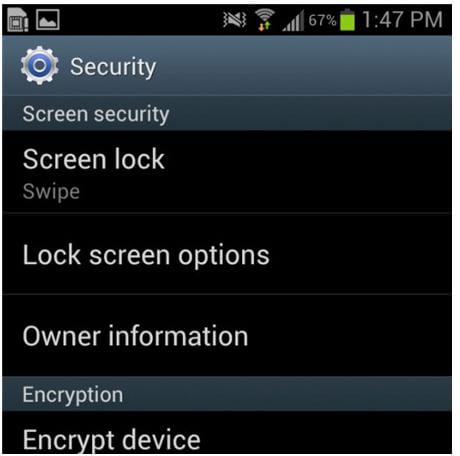
Step 4: Select the option called “Screen lock,” The next step is to enter your PIN code for security purposes. This step is carried out in Android phones to ensure you are the original owner of the Android device.
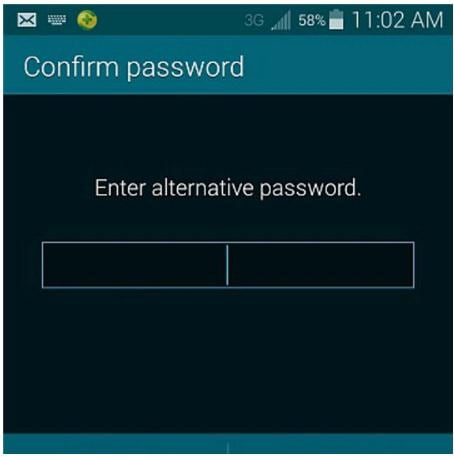
Step 5: If you click the PIN code option again, the drop-down menu will be listed with more options. Now select the option “None.”
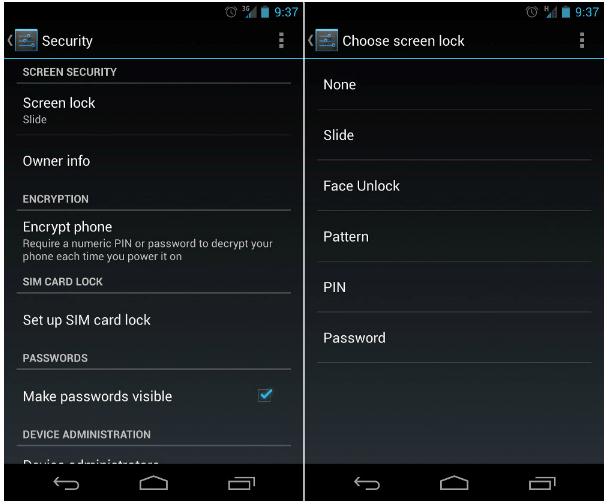
That’s all. You have successfully run out of the disable commands for the swipe up to unlock the screen. You can now open and access your device without any security methods.
Part 2:How to remove/bypass Swipe to unlock when the phone is locked?
To unlock your device, the only solution is to follow the Dr.Fone - Screen Unlock (Android) . If you are looking to unlock the screen when the phone is locked, then this method solidly proves to bypass swipe lock Android when it is locked. It helps to resolve this issue by bypassing or removing the swipe screen without causing any loss to your data. This tool temporarily supports bypassing Android screens without data loss on Samsung and LG. As for other Android phones, all the data will disappear after unlocking with this tool.
The features of this Dr.Fone software are many. It gives a solution to four lock methods: a pin, pattern, fingerprint, and password. It is user-friendly, and even a user with no technical information can also use it with no issue. This tool is only limited to remove the screen lock on Samsung and LG without losing data. Your data will still be wiped out on other Android phones after using this tool.
Dr.Fone - Screen Unlock (Android)
Remove 4 Types of Android Screen Lock without Data Loss
- It can remove four-screen lock types - pattern, PIN, password & fingerprints.
- Only remove the lock screen. No data loss at all.
- No tech knowledge asked. Everybody can handle it.
- Work for Samsung Galaxy S/Note/Tab series, and LG G2, G3, G4, etc.
4,008,669 people have downloaded it
Tips: This tool also supports unlocking other Android screens beyond Samsung and LG. However, it does not support saving all the data after unlocking, like Samsung and LG.
Step 1: Initialize the Dr.Fone on the computer, and there will be many options in front of you. In that, select the “Screen Unlock”.
Step 2: Now, to bypass swipe lock Android, using the USB cable, connect the Android device to your computer, and it will prompt the Unlock Android Screen option.

Step 3: To enable the download mode on your Android device, shut down your phone>Simultaneously, press the volume down, Home button, and Power button >Press the Volume up button. Once your device is in download mode, the recovery kit will get downloaded.

Step 4: You will see the result right in front of you as Dr.Fone - Screen Unlock, recovery will bypass swipe lock Android without hampering your data. Foremost, you can now access your device without swipe up to unlock the screen.

Pretty simple, right? Dr.Fone - Screen Unlock to the rescue for the issue of swipe screen to unlock.
Part 3: How to turn off the swipe to unlock when the pattern is enabled?
In this section, we will cover how to turn off the swipe to unlock when the pattern lock of the Google Pixel Fold device is enabled. Therefore, here we will go through the process of turning off the swipe to unlock the feature of your device. This structure is formed in some interval of locking the screen.
The steps below imply turning off of swiping screen instantly:
Step 1: At first, open the app “Setting” present on your Android device.
Step 2: There will be multiple interfaces. Now choose the option “Security.”
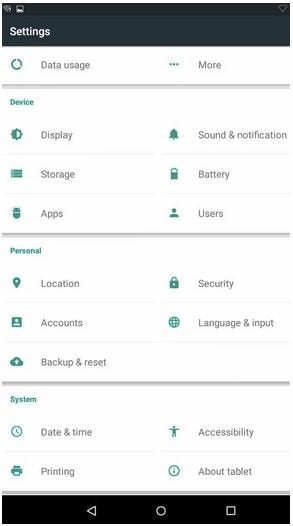
Step 3: To turn off the swipe screen, when the pattern is enabled then, choose “Screen lock” and then click on “NONE.”
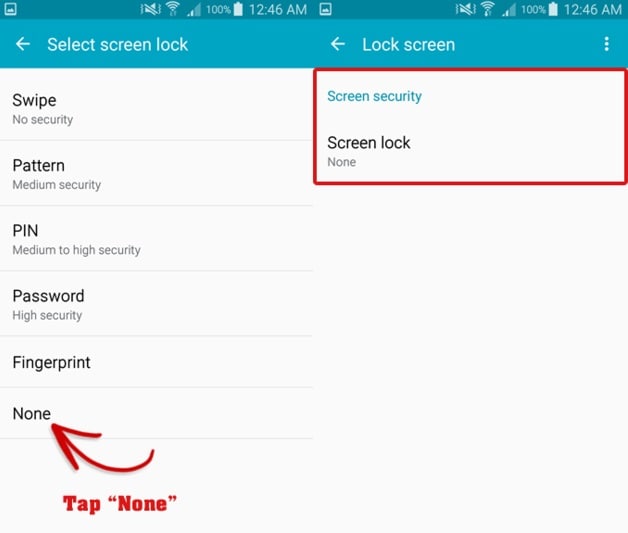
Step 4: If you have enabled your pattern choice already, it will again prompt you to enter the pattern. Once you entered the pattern, the swipe screen lock will disappear.
Step 5: The final step is to reboot your Android device to update the feature of turning off the swipe screen. Now you can open your device at any time without using the pattern lock feature.
Note: Regardless of any situation of forgetting the Android lock password, you can go for an email account set up for swiping into the Android devices.
Conclusion
Now, to sum up, we would say that in this article, we tried to bring out the best solutions for your Android device in such cases wherein you want to disable your screen security. The Dr.Fone - Screen Unlock is simply a proven mechanism that delivers what we need and that, too, without any data loss. We ensure that you can disable the swipe screen to unlock easily and effectively using the methods given above. Hence, you can access your phone by bypassing swipe lock Android even if you forget the screen lock code. So, don’t just wait, but bring out the solution for the swipe screen to unlock the Android device with Dr.Fone - Screen Unlock (Android) now.
How To Enable USB Debugging on a Locked Google Pixel Fold Phone
Unlocking your Android’s potential goes beyond its surface features. Understanding USB debugging is key to troubleshooting and maximizing your device’s capabilities. In simple terms, USB debugging allows deeper access to your phone’s functionalities, aiding in software development and data recovery.
However, enabling USB debugging becomes crucial yet challenging when your phone is locked. This article delves into this necessity, explaining how to enable USB debugging on locked phones, especially for Android users. Unravel the mystery behind this essential feature, empowering yourself to navigate through locked phone scenarios effortlessly.

Part I. Challenges in Enabling USB Debugging on a Locked Android Phone
USB debugging is a nifty tool that lets you peek behind the scenes of your Android phone’s software. It’s like having a secret key that unlocks deeper access to your device, enabling tasks like software tweaking, app testing, and even data recovery.

Challenges in Enabling USB Debugging on a Locked Phone
Outlined below are some of the barriers, scenarios, and limitations, shedding light on the challenges that make USB debugging seemingly impossible.
- **Locked-out access.**When your phone is locked, gaining access to the settings becomes a roadblock to enabling USB debugging.
- **Limited functionality.**The phone’s locked state restricts the usual methods of accessing developer settings and USB debugging options.
- **Security measures.**For security reasons, most devices limit access to sensitive settings when the phone is locked, making it tricky to enable USB debugging.
Scenarios Requiring USB Debugging on a Locked Phone
Unlocking your phone’s potential becomes crucial in moments of crisis. Explore below some of the scenarios where enabling USB debugging on a locked Android device becomes your beacon of hope:
- **Data recovery.**Imagine accidentally locking yourself out of your phone with important data inside. Enabling USB debugging could be your ticket to retrieve that precious information.
- **Software troubleshooting.**Sometimes, a locked phone might need software fixes or troubleshooting that requires USB debugging to access certain tools.
- **Device testing.**For developers or tech-savvy users, testing new apps or debugging software issues often demands enabling USB debugging, even when the phone is locked.
Part II. How To Enable USB Debugging on Locked Phones
This section outlines the traditional method of enabling USB debugging on an Android phone. Stay tuned and check out the steps below:
- Step 1: Unlock your device**.** If needed, enter your phone’s passcode or pattern to gain access to the Settings.
- Step 2: Go to Settings, scroll down to About Phone, and tap on Build number seven or eight times to unlock the Developer Options.

Step 3: Once unlocked, return to Settings, find Developer Options (usually at the bottom), and enter the menu. Enable USB Debugging by tapping OK once the Allow USB Debugging? message appears.

However, what if your phone remains locked, making these steps impossible? Such a case calls for an alternative solution. Fortunately, there is one tool that is fully reliable when it comes to unlocking locked mobile devices. Dr.Fone - Screen Unlock (Android) can help bypass these challenges and enable USB debugging on a locked Android phone effortlessly. So, buckle up as the next section unravels the secrets to unlock your device’s potential!
Part III. Seamlessly Unlock Your Android With a Professional Resolution
Enabling USB debugging on a locked phone can feel like navigating a maze with no clear exit. Sometimes, despite your best efforts, the traditional method fails to grant access. Fret not! There’s a smoother path that unlocks your phone and eases the USB debugging hurdle.

Why Unlocking First Makes Sense
Attempting to enable USB debugging on locked phones can hit roadblocks. That’s why unlocking your device first becomes a game-changer. Dr.Fone – Screen Unlock (Android) is the hero of this story, simplifying the process and ensuring a hassle-free experience.
Key Features and Benefits
Check out the amazing key features and benefits of Dr.Fone – Screen Unlock that fits Android devices:
- **Data safety and reliability.**Your data’s security remains paramount. With Dr.Fone – Screen Unlock, your device’s integrity and precious data stay safeguarded throughout the unlocking process.
- Dr.Fone - Screen Unlock is compatible with a wide range of Android devices, irrespective of brand or model, ensuring accessibility for various users.
- It’s not just about unlocking a locked screen; Dr.Fone offers multiple unlock modes tailored to different scenarios, whether a forgotten password, PIN, pattern, or fingerprint issue.
- **High success rate.**With a high success rate in unlocking locked screens, Dr.Fone - Screen Unlock provides a reliable solution, even for complex lock scenarios.
- **No data loss.**Users can rejoice in the fact that the unlocking process doesn’t compromise data integrity. Your photos, messages, and apps remain untouched and secure.
- **Ease of use.**The software is designed for simplicity, making the unlocking process accessible to users with varying levels of technical expertise.
Tips: Forget your device password and can’t get access to it? No worries as Dr.Fone is here to help you. Download it and start a seamless unlock experience!
Guide To Unlock Your Google Pixel Fold With Dr.Fone – Screen Unlock (Android)
Below are the steps on how you can unlock your Android device using Dr.Fone:
Step 1: Get the most recent version of Wondershare Dr.Fone and connect your Android device to your computer via a USB cord. After connecting, access the unlock screen tool by going to the Toolbox and then selecting Screen Unlock.
Step 2: Once prompted, choose Android to unlock your Android screen lock. On the following screen, you’ll see two options; choose Unlock Android Screen.

- Step 3: After that, you’ll be taken to a new screen where you can choose the brand of your mobile device.

- Step 4: Once done, click the Remove without Data Loss button from the two options presented on the screen.

- Step 5: Unlocking the Android screen requires choosing the Brand, Device Name, and Device Model next. Enable the option that says I agree with the warning, and I am ready to proceed by clicking the corresponding checkbox. To proceed with unlocking the screen, click Next.

- Step 6: Type 000000 when asked to confirm the process. After entering the code, click Confirm to run the program.

- Step 7: Once you’ve recognized your Android device’s model, Dr. Fone will walk you through entering Download Mode. Following the on-screen prompts will take you directly to the next screen. It then depicts the progress of the screen unlocking procedure, in which the platform’s required drivers and configuration files are downloaded.

- Step 8: A new screen will appear, indicating the process has been completed. Click Done if your device’s screen unlock issue has been successfully fixed. If not, click the Try Again button.
Dr.Fone – Screen Unlock (Android) acts as your trusty guide, leading you through the maze of locked screens and inaccessible settings. It unlocks your phone first and enables USB debugging without the frustrating barriers.
Learn More About Android Unlock:
Samsung Unlock Codes to Unlock Samsung Phones [2024 Updated]
Unlocking Your Realme Phone Made Easy: No Data Loss!
The Best Android Unlock Software of 2024
Conclusion
In face of locked screens, USB debugging is a beacon of access and troubleshooting for your Android device. Remember, enabling USB debugging on a locked phone is crucial, opening doors to unforeseen solutions. However, what if you want to enable USB debugging on locked phones, but the process gets messy?
Then, it’s time to consider Dr.Fone - Screen Unlock (Android). It effortlessly paves the way to enable USB debugging on locked phones. By ensuring your device’s security and accessibility, even in locked states, Dr.Fone empowers you to navigate through obstacles, safeguarding your data while unlocking endless possibilities.
Also read:
- [New] Engaging Audiences on Instagram The Power of Creative Puzzles for 2024
- [Updated] In 2024, Pixel Power Unveiling YouTube's Twitter Crew
- A Complete Guide To OEM Unlocking on Xiaomi Redmi Note 12 Pro 5G
- Beating the Pressure with Conversational AI: Insights From ChatGPT
- Full Tutorial to Bypass Your Honor 70 Lite 5G Face Lock?
- Gratuito Conversor Online De Vídeo: OGV Para OGG Pela Movavi
- How To Enable USB Debugging on a Locked Infinix Hot 40 Pro Phone
- How to Lock Apps on Xiaomi 13T Pro to Protect Your Individual Information
- How to View Old Stories on Facebook for 2024
- In 2024, Can I Bypass a Forgotten Phone Password Of Xiaomi 14 Ultra?
- In 2024, Decoding DuRecorder Features and User Guide Review
- In 2024, How To Fix OEM Unlock Missing on Infinix Note 30 5G?
- In 2024, Pin-to-Play The Ultimate Free Pinterest Video Download Guide
- In 2024, Scripting Striking Film Epilogues
- In 2024, Unlock Vivo V30 Phone Password Without Factory Reset Full Guide Here
- Windows 10: Resolved Intel & Nvidia Graphics Switch
- Title: In 2024, Rootjunky APK To Bypass Google FRP Lock For Google Pixel Fold
- Author: Marry
- Created at : 2024-10-23 17:36:42
- Updated at : 2024-10-25 17:20:49
- Link: https://unlock-android.techidaily.com/in-2024-rootjunky-apk-to-bypass-google-frp-lock-for-google-pixel-fold-by-drfone-android/
- License: This work is licensed under CC BY-NC-SA 4.0.